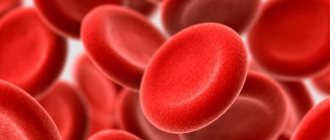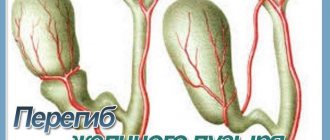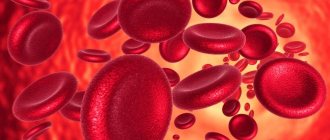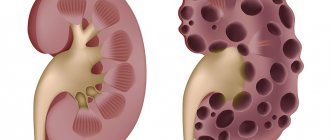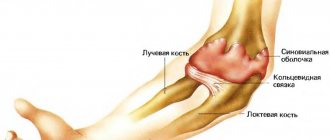Normal hemoglobin level in humans
To determine the concentration of this indicator in biological fluid, the patient will have to perform a general blood test in the laboratory. The ideal level varies between 120-150 grams per 1 liter, but such standards can be pathologically overestimated or underestimated due to internal diseases of the body. For example, in the fairer sex, a decrease in protein is triggered by the arrival of the next menstruation. For the male body, there is a different norm of hemoglobin in the blood; a limit of 135-180 grams per 1 liter is considered acceptable.
Separately, it is worth clarifying that carboxyhemoglobin is another protein from the chemical composition of the blood, which is a compound of carbon monoxide and hemoglobin. Its value must be constantly reduced, otherwise oxygen starvation and pronounced symptoms of general intoxication of the body occur. To lower carboxyhemoglobin, you need to contact a specialist to determine the real clinical picture using a laboratory method.
Hemoglobin is higher than normal
If, according to the test results, there is a deviation from the permissible values, pathology has occurred. It is possible that if the chemical composition of the blood is disturbed, a latent disease develops in the body, which must be diagnosed and treated in a timely manner. The doctor’s task is to use laboratory methods to determine the fact and reason for the deviation of the protein concentration from the acceptable values according to the age category. If the norm of hemoglobin content is violated, the etiology of the pathological process may be as follows:
- intestinal obstruction;
- pulmonary failure;
- Congenital heart defect;
- thermal burns;
- diabetes mellitus, including latent form;
- oncological diseases;
- progressive hemoglobinemia;
- excessive blood thickness;
- hypervitaminosis with B vitamins;
- heart failure.
Below normal
If in a once healthy body this indicator pathologically decreases, iron deficiency anemia progresses, oxygen starvation occurs, followed by cell death. The condition is extremely dangerous for the entire body, since there is general weakness, signs of intoxication of the body and serious problems with the functioning of the immune system. Each patient must know what hemoglobin level is allowed, and what methods can be used to achieve the required value in the case of progressive pathology. There are several reasons why protein concentration is reduced. This:
- diseases that cause bleeding;
- deficiency of folic acid and vitamin B12;
- blood transfusion;
- haemorrhoids;
- pathologies of the reproductive system;
- breastfeeding period;
- autoimmune and hereditary diseases;
- the course of infectious processes;
- pregnancy;
- hypoglycemia.
Why does hemoglobin increase?
An increase in hemoglobin levels can be caused by smoking, dehydration or oxygen deprivation (for example, during a long stay high in the mountains). Obesity, lung problems and sleep apnea also lead to increased hemoglobin levels.
On topic: When a person sleeps poorly three nights a week, this is already a disease
Hypertensive patients who regularly take diuretics may also experience an increase in hemoglobin. Medicines that contain a diuretic thicken the blood. This leads to an increase in the mass of red blood cells and, as a result, an increase in hemoglobin.
If a person does not smoke, does not live in the mountains and does not snore at night, does not take diuretics, but hemoglobin is still elevated, it is worth checking the kidneys. The fact is that the kidneys produce the hormone erythropoietin, which controls the formation of red blood cells. If there are too many red blood cells, this may indicate kidney pathology - even a tumor.
Depositphotos
Another problem that an increase in hemoglobin may indicate is uterine fibroids (a benign tumor of the uterus). You can often hear the opinion that with uterine fibroids, the level of hemoglobin drops. This is true, but there may be exceptions. For example, if fibroids are accompanied by minor bleeding.
It is important to know: What is the endometrium. Endometrial polyp, causes and treatment
Often, an increase in hemoglobin levels may be asymptomatic. The CBC allows you to determine whether hemoglobin is elevated or not.
Normal hemoglobin level in women
Depending on the age category, protein concentration has certain limits. For representatives of the fairer sex, they vary depending on the period of the month and are distinguished by their unstable indicators. Ideally, normal hemoglobin in a woman from 18 to 60 years old varies between 120-150 grams per liter of blood. In other clinical pictures we are talking about pathology. If hemoglobin is normal, there are no alarming symptoms that reduce the quality and productivity of everyday life.
When the period of monthly menstruation arrives, do not be surprised if the concentration of protein in the blood rapidly decreases. This is a normal phenomenon, which is explained by the usual blood loss in the female body. The permissible limit stabilizes on days 7-10 of the menstrual cycle, and such natural changes in the norm (decrease) occur monthly.
During pregnancy
Since the blood volume almost doubles during pregnancy, a general analysis of this biological fluid determines a sharp decrease in hemoglobin. Such a violation against the background of hormonal changes in the body negatively affects the general well-being of a pregnant woman. Doctors report: the norm of hemoglobin in pregnant women in the 1st and 3rd trimester is 110 g/l, at the onset of the second trimester it is 105 g/l. If these limits are violated, immediate treatment is required, even during pregnancy.
It is important to note: if the chemical composition of the blood is not normalized, not only the body of the expectant mother suffers, but also the unborn baby. To reduce the risk of iron deficiency anemia, you need to change your usual diet, take vitamins in natural foods and tablets, and follow all preventive measures as recommended by your doctor.
For women by age, table
Minor deviations of this indicator in the blood are resolved and are not a pathology. Normal hemoglobin is rather an abstract concept, the meaning of which changes as a particular patient grows older. This is due to the hormonal characteristics of the female body. The norm of hemoglobin in the blood of women, from one year of age to old age, is detailed in the table below. So:
| Woman's age, years | What should hemoglobin be, g/l |
| 12-18 | 120-160 |
| 18-60 | 120-150 |
| from 60 | 117-138 |
Symptoms of elevated hemoglobin
It is believed that increased hemoglobin is not as dangerous as decreased one, but this is not entirely fair. Too much of this protein, as well as a high concentration of red blood cells, is a serious disorder that can lead to unpleasant consequences.
Increased hemoglobin increases blood viscosity. Because of this, the speed of blood flow is significantly reduced. In small vessels, blood circulation slows down, and stagnation, for example, stasis, often appears here.
Such a change in the rheological properties of blood often provokes the occurrence of thrombosis - blood clots made of red blood cells, platelets and leukocytes, which can clog a small vessel and lead to ischemia (circulatory failure) of those tissues that are supplied with blood from it. If this occurs in vital organs (lungs, brain, heart), then very complex pathologies such as heart attack, stroke or pulmonary embolism may occur.
Therefore, you should not ignore a significant increase in hemoglobin content in the blood. This sign is a serious reason to contact a specialist. The doctor will conduct a full examination, find the cause of the symptom and prescribe appropriate treatment procedures.
Normal hemoglobin level in children
In childhood, pediatricians also monitor the amount of protein in the systemic circulation. The first blood test is performed in the maternity hospital the day after the baby is born. The norm of hemoglobin in a newborn allows limits of 135-200 grams per 1 liter of blood. Already in the second week of life, this figure decreases significantly. There are already other acceptable limits that confirm the perfect health of the baby. For children, hemoglobin is considered normal if the protein level meets the following limits:
- in a child up to 2 weeks of life – 135-200 g/l;
- from 2 weeks to 1 month – 115-180 g/l;
- in a one-month-old baby – 90-130 g/l;
- in infancy 2-6 months – 95-140 g/l;
- protein concentration in infants 6-12 months – 105-140 g/l;
- limit for 1-5 years – 100-140 g/l (average value – 120 g/l);
- the permissible value for a child 5-12 years old is 115-145 g/l.
Signs of high hemoglobin
Typically, elevated levels of iron-containing protein are detected during blood donation, but there are a number of external signs that may indicate such a disorder:
- drowsiness or insomnia;
- joint pain;
- fatigue and lethargy;
- redness or paleness of the skin;
- increased thrombus formation;
- decreased or lack of appetite;
- increased blood pressure;
- decreased hearing or visual acuity;
- dizziness and headaches;
- heavy sweating;
- bone pain;
- painful numbness or burning of the extremities;
- problems with concentration and memory;
- slight increase in temperature;
- frequent digestive disorders;
- itchy skin.
All these are nonspecific symptoms that do not necessarily indicate an excess of hemoglobin. Only blood tests can accurately determine the deviation.
Normal hemoglobin level in men
In a woman, especially a pregnant woman, the protein level is noticeably different from the male body. For such a clinical picture, completely different limits are appropriate, which are important to monitor in a timely manner. Hemoglobin levels are normally higher in men, which is explained by the behavior of the hormone testosterone. In addition, representatives of the stronger sex are characterized by physical activity, which directly affects the concentration of protein in the blood. So:
- 12-18 years – 130-160 g/l;
- 18-60 years old – 136-177 g/l;
- men over 60 years old – 125-150 g/l.
What leads to a decrease in hemoglobin levels
Iron protein deficiency does not develop just like that. It can be caused by a variety of reasons or be a symptom of any disease.
The most common are:
- Pregnancy, during which severe and persistent toxicosis appears.
- Side effects of certain medications.
- Heavy bleeding.
- Poor nutrition.
- Smoking.
- Frequent stress on the body.
- Frequent stressful situations.
Diseases that are accompanied by iron deficiency include:
- infections;
- hereditary pathologies - lead to the destruction or disruption of the integrity of red blood cells (these diseases also lead to a decrease in the existence of blood cells);
- jaundice;
- severe blood loss resulting from open injuries, operations, etc.;
- hidden pathologies of the digestive system;
- oncology;
- chemotherapy;
- helminthic infestations.
These and other conditions often lead a person to iron loss.
Norm of glycated hemoglobin in diabetes
Since in patients with diabetes the composition of biological fluids (blood and urine) is somewhat different from healthy patients, hemoglobin also has its differences - the norm is determined by the nature of the disease, its course, and specifics. There is a separate test for glycosylated protein, without which it is impossible to determine the composition of the blood and prescribe intensive therapy for diabetes mellitus. Such laboratory testing is considered mandatory, even if the patient is only suspected of having this terrible and already incurable disease.
The norm of glycated hemoglobin in women is 4.6-6.5% of the total sugar level. If the real indicator reflects the limits of 6.5-6.9%, doctors suspect the presence of diabetes mellitus in a man or woman; pregnant women are also no exception. Patients at risk are taken under medical supervision, and a typical laboratory test must be repeated every three months on an empty stomach.
Find out what the testosterone level is in women.
Why is a deficiency of an element dangerous?
The risk group primarily includes women during pregnancy, adolescents and older people who have a natural decrease in immunity.
With low iron levels for a long time, a variety of health problems can develop. One such disorder is a problem in the immune system. As a result of this reason, even a common cold will be very difficult, and there will be a high probability of serious complications. The body will not be able to fully protect itself from harmful microbes, which poses a threat not only to the health, but also to the life of the patient.
Impaired immunity leads to the following consequences:
- transition of many diseases to chronic stages;
- osteochondrosis, and then osteoporosis;
- hair falls out, teeth deteriorate and nails crumble;
- children experience delays in growth and development;
- heart failure develops;
- liver enlargement occurs.
When carrying a baby, iron deficiency poses a danger for both mother and child. In this condition, there are not enough red blood cells, both for the woman and the fetus - and it is important for him to provide proper and healthy nutrition, which will contain enough elements important for health.
When the hemoglobin level drops below 70 g/l, a critical stage of anemia occurs. And such a patient needs urgent help. It is possible to restore the level of iron-containing protein in the blood with the help of various medications, proper diet and folk recipes.
The attending physician will tell the pregnant woman to adjust her diet - the diet should include meat, liver, vegetables and fruits, herbs, and cereals. If this “move” does not improve the results, the doctor may recommend taking iron supplements.
Despite the fact that iron from foods of animal origin is absorbed much better than from plant foods, you should not limit your diet to eating only meat products. Buckwheat, apples, pomegranate - these and other foods rich in iron must be present on the table. It is also worth knowing that you should not consume iron-containing foods and preparations with tea, milk or coffee, since these drinks make it difficult to absorb the microelement.
Low hemoglobin in men can be an independent disease - anemia, anemia, or develop with other pathologies. Healthy men have more hemoglobin than women. This is due to the presence of significant muscle mass, which needs a good blood supply with oxygen-enriched blood. With low hemoglobin in men, only a doctor can determine the reasons.
Symptoms of deviation
If a woman has hemoglobin 100, this will definitely manifest itself. As this indicator decreases, the appearance deteriorates, so the deviation is noticeable even without laboratory testing.
Symptoms include the following:
- The skin becomes pale or bruises appear on it. The skin becomes dry and peels.
- Nails lose strength and break.
- Hair is falling out a lot.
- The face becomes puffy.
Hemoglobin 102 in women causes not only a deterioration in appearance. A person may also feel physically unwell. It manifests itself in the following:
- Weakness throughout the body, drowsiness.
- Fast fatiguability.
- Regular headaches.
- Dizziness.
- Lack of oxygen.
- Problems with blood pressure.
- Loss of consciousness.
Important! If such signs appear, it is recommended to urgently undergo a laboratory test and inform your doctor. You may need to take medications for anemia.
Headaches due to anemia
Low hemoglobin level
If the concentration of hemoglobin in the blood decreases, this condition is considered anemia. There are many prerequisites for its development. These include dangerous chronic diseases that lead to heavy internal bleeding, ulcerative pathologies, and a lack of important vitamins, especially B12 and folic acid. These substances are needed for the production of blood cells.
Increased and decreased hemoglobin
Reduced hemoglobin can result from the loss of a large amount of blood, hypoglycemia, or hemolytic anemia. Often, girls who follow strict diets suffer from anemia, since little food enters the body, and therefore there is also a lack of iron. Hemoglobin 109 in a woman is already considered insufficient, especially when menopause occurs.

